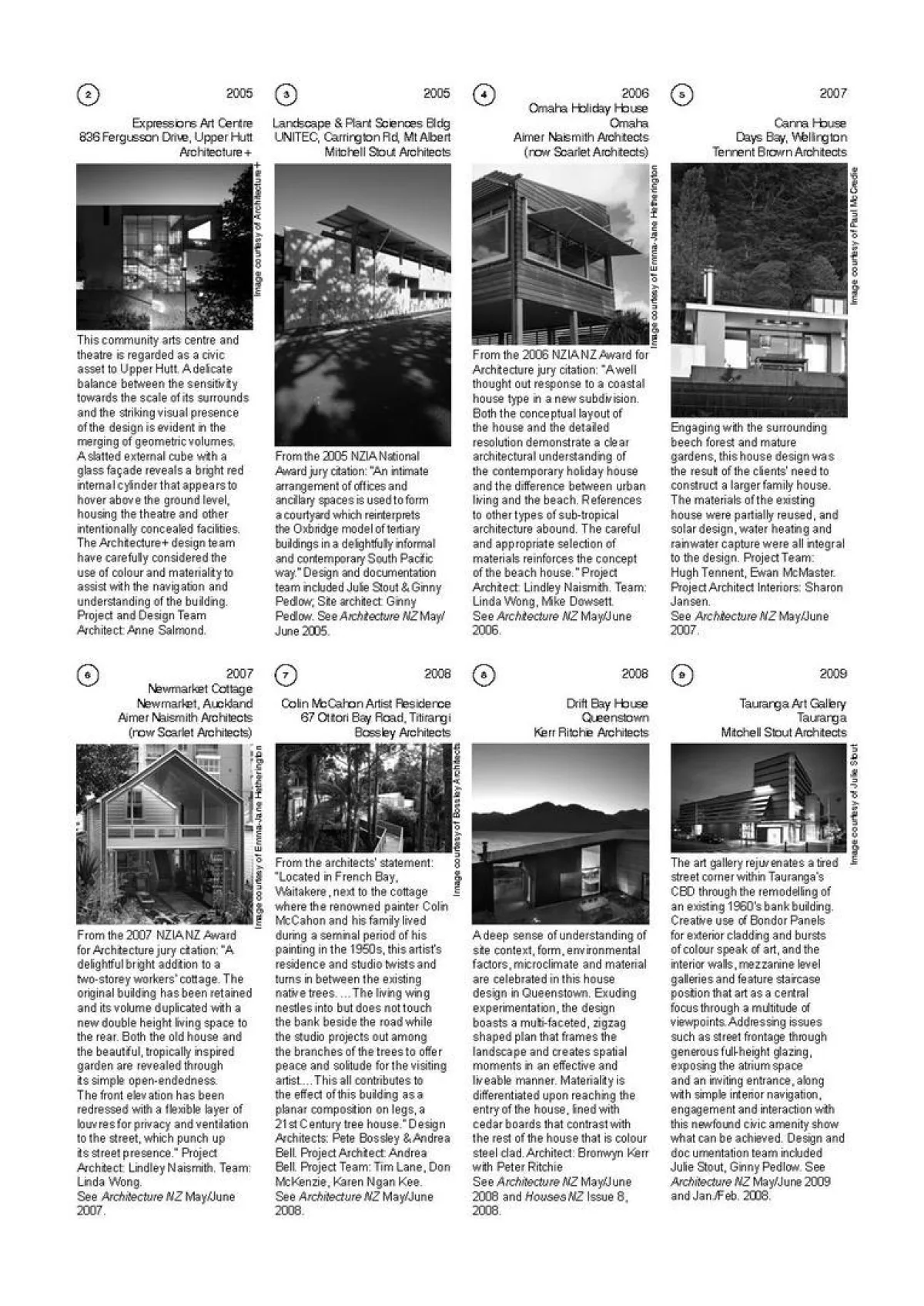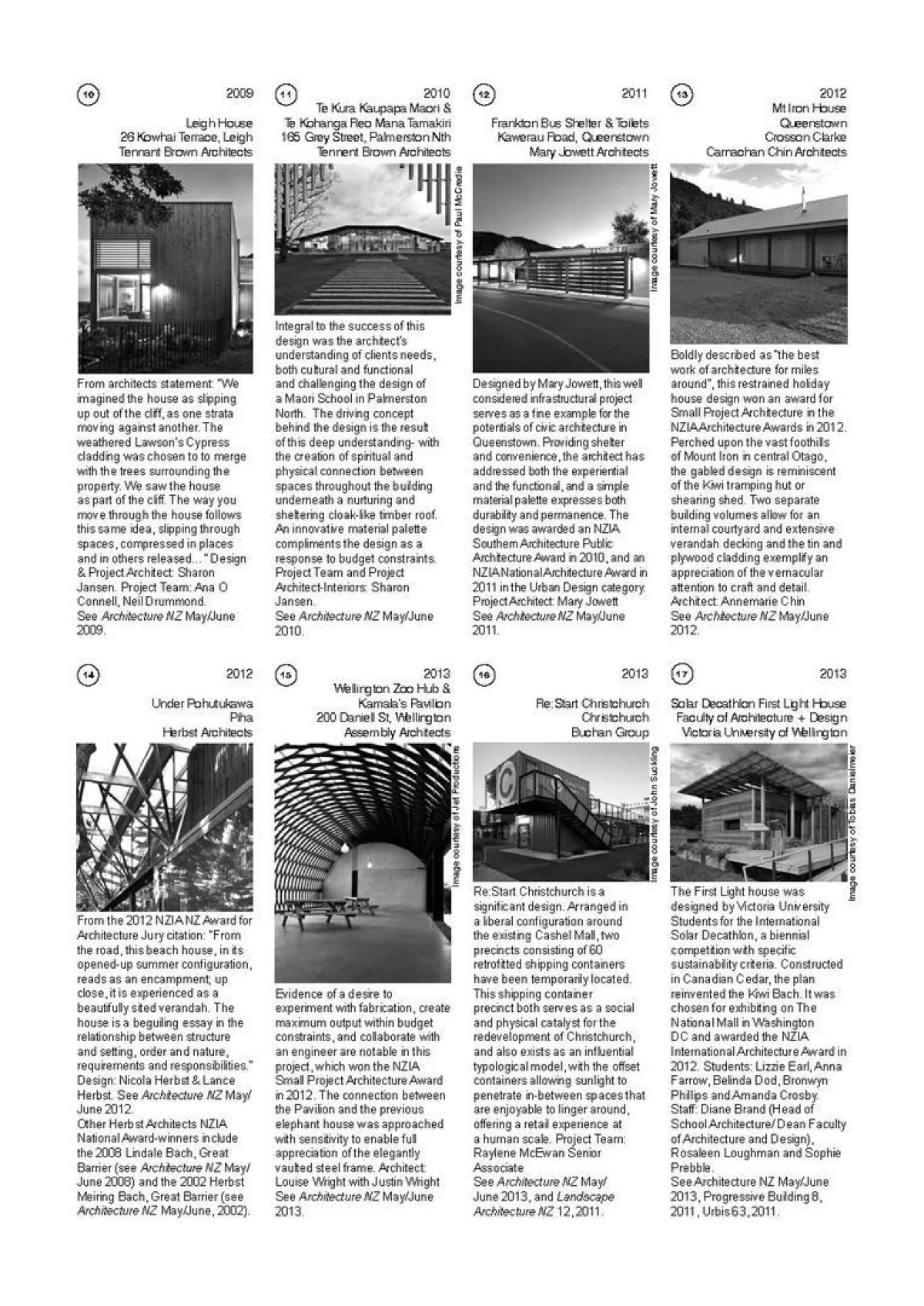Block Itinerary no.49
21 May 2014
Architecture by Women 2003-2013 Block Itinerary No. 49
Block Architecture Guides are published with the Broadsheet of the Auckland Branch of the NZIA - contact [email protected] for more information
A Question of Authorship Megan Rule and Lynda Simmons, September 2013.
“Only god or her would ever know just how many great solutions with the imprimatur of one of the male heroes of SOM, owed so much to her, than was attributed by either SOM or the client” Nathaniel Owings, 1988 Autobiography
We are reminded that US Architect Natalie De Bois, who died in July 2013 at 92, was a significant driving force of one of the earliest Pritzker Prize winners, Gordon Bunshaft, for their work at SOM in the mid twentieth century. Low visibility of women working in architecture is an issue that can be reinvestigated in contemporary times, and is one of the primary reasons behind the creation of the Architecture+Women•NZ website database.
A Block Guide based on gender may to some be controversial, however architecture via theme is not generally considered to be. Architectural projects are often grouped or curated under themes, for example projects of a decade [1], projects generated by a single client [2], or projects which reflect social movements [3]. It is often easiest, though, to study architecture through the author of the work, and itineraries such as these are most often put together around the output of a single architect or practice.
While this method is easily accessible and can provide a personal touch, it can present many complex issues around authorship of work. It is especially difficult in areas of publication, from magazines to academic articles and books, where omission of project team members can leave often talented architects unseen under practice banner names. Conversely, where specific team members are named, work can in the public eye become attributed to them rather than the practice, despite the practice history and its risk investment around the project.
When researching for projects to include in this Architecture + Women • NZ itinerary, difficulties in acknowledging the many talented architects, of both genders, became very apparent. There are many excellent buildings by women not included here, due to authorship issues in both publication and awards structures. (eg. where award submission forms inadvertently structuring questions which can conceal relevant team members.)
One measure of the level of visibility of New Zealand women architects is by looking closely at the national architectural awards programme, run by the NZIA. These awards form one of the three criteria for inclusion in the Block Family Tree genealogy chart (version 1.0 May 2008) and are an important and relevant measure of New Zealand’s architectural canon.
This itinerary looks only at award-winning work at a ‘New Zealand Architecture Award’ level (previously named Regional Award) and includes work produced throughout all regions of New Zealand from 1993 to 2013. This 20 year period covers the gap between two Architecture and Women exhibitions - Constructive Agenda in 1993 and the national A+W•NZ exhibition held in September 2013[4]. It offers an insight into rates of change in the industry around gender equity and workplace culture.
The criteria for the itinerary selection supposedly allows us to find only the projects, led by women, which have been awarded NZIA National Level (not Local) Awards. To see what is visible at the top. There were not as many examples as we expected to select from, with perhaps the most surprising result being the lack of women-led practices at this level. Many of the practices included here have strong male leaders, with the dangerous tendency for the female component to be dropped off in the minds of those considering the work. This happens often, as the recent petition and discussion around Denise Scott-Brown’s exclusion from Robert Venturi’s Pritzker Prize in 1991 has reminded us. (A recent letter to the editor in NZArchitect points out this is not a historical phenomenon. Mike Austin points to a typical dropping of the female team member when abbreviating male + female duos. NZArchitect 1/2013.)
The other clear finding in preparing this itinerary was that there are many more awarded projects designed by women, than those listed here. While anecdotally known, these have been deliberately excluded to call attention to the publishing practice that leaves no trace of the women involved.[5] Such issues of authorship and recognition obviously extend across gender, and A+W•NZ firmly believe that focusing on a single and not insignificant group within the wider architectural community, benefits extend to all.
[1] For example Block Itinerary n.37 ‘Auckland City in the 1990s’
[2] For example Block Itinerary n.32 ‘’State Housing in Auckland.’
[3] For example Block Itinerary n.46 ‘’Pakeha Settlement in Northland.’
[4] Between Silos in Auckland, Diverse Practice in Wellington, Re-Think in Christchurch and Small Town Girl? in Queenstown.
[5] For example, both authors of this itinerary have been recipients of NZIA National Level awards, under other practice names, (CITY Design Ltd, Andrew Patterson Architects) This is common and not restricted to gender.


A survey was conducted of the NZIA Award programme for the period 1993-2013, to see the number of visible women who were the recipients of Regional/National (not Local) Level awards, by Megan Rule and Lynda Simmons.
The results show that 6.5% of awards went to female architects during these two decades, 17 awards out of 262 conferred.
The reasons for this have not been analysed here, but the identified obvious gap in the current awards system was a catalyst for the establishment of the A+W NZ Awards in 2014.












